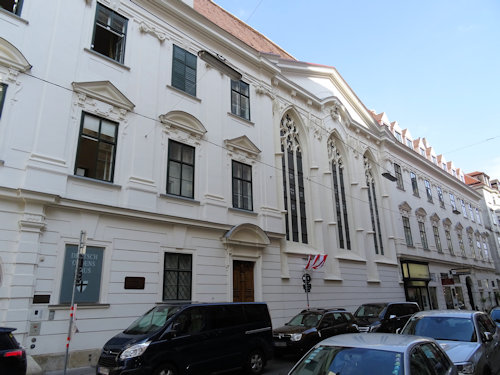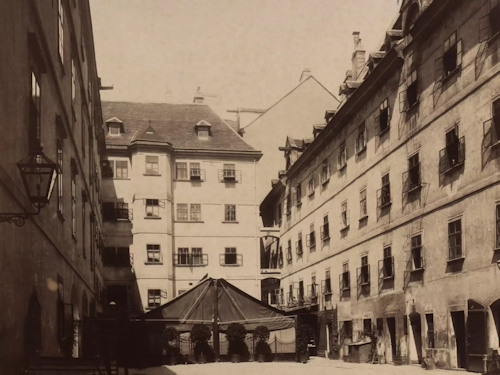
Nearly all historical concert venues in Vienna can lay claim to one or other composer having once played there. In the case of the Deutschordenshaus, two actually lived there. Including a promising musician named Mozart. (I wonder what became of him?)
- Home to the Teutonic Order in Austria
- Mozart stayed here in 1781 (and Brahms later)
- Hosts regular concerts by the Mozart Ensemble Vienna
- Book a concert experience* for your stay
- See also:
- Concert venues in Vienna
- Mozart locations
- Brahms locations
History, music & more

(The façade along Singerstraße)
The house and courtyards of the Deutschordenshaus belong to the Deutscher Orden (Teutonic Order) and date as far back as the early 13th century, just a few years after the order’s establishment in 1190 in Acre (now in modern-day Israel).
Needless to say, the buildings have all undergone one or two changes in the meantime: much of what you see from the outside is 17th and 18th century in design.
As the headquarters of the Austrian branch of the order, this remains a working institution with its own church and treasury.
The on-site guest house might interest you in particular, given it counts among the places to stay that are closest to the centre of Vienna.
The musical connection
Brahms lived in the Deutschordenshaus briefly, which would normally be enough to give a location classical prestige.
But even a Brahms suffers in comparison to the main musical connection: the Archbishop of Salzburg (Hieronymus von Colloredo) stayed here in 1781, and his retinue of employees included a certain W. Mozart.

(Inner courtyard view, as photographed around 1902 by August Stauda; Wien Museum Inv.-Nr. 27744; excerpt reproduced with permission under the terms of the CC0 licence)
Colloredo failed to approve of Mozart performing outside of the Archbishop’s residence, which didn’t sit well with a young composer growing in fame and looking to make his mark in the big city and wider world.
The resulting arguments eventually ended with Colloredo’s steward kicking (literally and figuratively) Mozart out of the door. Fortunately, the Archbishop’s loss was our gain.
With connections to Salzburg now severed, Mozart remained in Vienna and the rest is, as they say, history. A plaque just inside the entrance to the Deutschordenshaus on the right-hand wall commemorates the composer’s stay; you can just about see it without going inside.
Over 200 years later and Mozart’s back, so to speak.
The concerts
At the time of writing, the Mozart Ensemble Vienna perform in the Deutschordenshaus throughout the year (and dressed in period costume).
The program features the music of those composers closely associated with Vienna, including Mozart, but also Beethoven, Schubert, Haydn, and others.
A notable feature of these concerts is the location: the Sala Terrena room, with its walls and domed ceiling covered in 18th-century frescoes.
To reach the Sala Terrena, you have to pass through a lovely old courtyard with one of Stephansdom cathedral‘s towers rising above the walls. It looks particularly imposing at night, when the tower lights up.
NB: The concerts take place in the “Mozarthaus” or “Mozart’s House”, so be careful when looking for it. The term Mozarthaus is commonly used for the museum on Domgasse; you want the house on Singerstraße.

(The church tower, which makes a brief appearance in the Netflex series The Recruit)
How to get to the Deutschordenshaus
As mentioned, the venue is close to the main cathedral and actually only a street away from that Mozarthaus Museum.
Carry on up Singerstraße away from the centre and you reach another musical landmark: Schubert used to drop into the Zu den 3 Hacken inn for a bit of refreshment between compositions.
Subway: Take the U1 or U3 lines to Stephansplatz station and the Kärntner Straße pedestrian exit pops you out at the end of Singerstraße.
Bus: Take the 1A, 2A or 3A to Stephansplatz and it’s a 5 minute or so walk.
Address: Singerstraße 7, 1010 Vienna